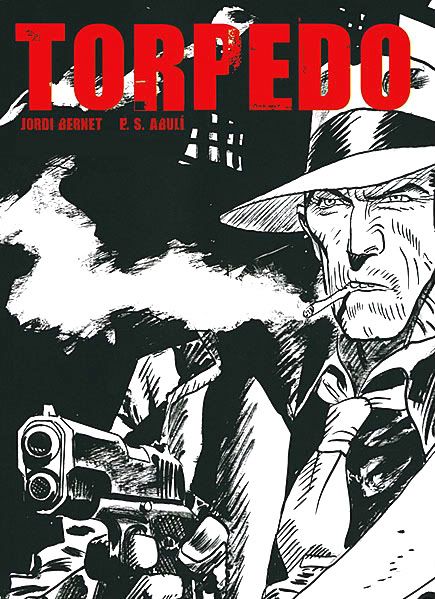 Torpedo
TorpedoPublisher: Cross Cult
Writer: E.S. Arbuli
Artists: Alex Toth, Jordi Bernet
There are many artists whose work I love, but few whose art sends me as delirious as Alex Toth's. Toth did a number of superhero books, but his forte was period action, especially when it involved classic cars and airplanes. Toth would envision the panels as scenes snipped from contemporaneous films, so you'd almost expect to see Errol Flynn stride in with a dame on each arm, or James Cagney pop up with a tommy-gun and start blasting away at Humphrey Bogart while Ingrid Bergman gazes through a curl of cigarette smoke as she lounges seductively near a piano, or a dishevelled Rita Hayworth curled up in bed, wearing your pajamas.
I can't really review E.S. Arbuli's writing here because for some reason, I ended up with the German edition of Torpedo. All I know is, Cross Cult did Torpedo proud; it's a handsome book. I love how companies are going to this "textbook" style binding with strong, modern graphics on the covers. Dark Horse prints a few book along this style, the European "album" format. The interior pages are in lush black and white, and if it suffers in any way, it's from being smallish; I suppose Dark Horse's Creepy and Eerie archive books have spoiled me rotten . I'm sure they have. Torpedo's dimensions are smaller than letter-sized paper, slightly larger than digest-sized. Which means some of the linework, especially in Toth's stories, gets lost and the panels tend to look a bit busy.
But that's a very minor problem. Once you focus your eyes and pull the book a little closer, the art looks quite beautiful. Toth handles the visuals on the first two installments, entitled "Torpedo 1936." And true to form, he brings Torpedo's 30s milieu to life. It's like reading some gangster flick of the time. Toth uses silhouetting extensively throughout, befitting the dark events. Cigarette smoking gangsters rattle away with machine guns and blaze away with .45 automatic pistols. Toth works loose and textural, with slashes of black to give energy and movement to the images. It's some of his finest work, but apparently he didn't feel his sensibilities meshed with Arbuli's, despite the mid-30s stuff he depicts so well. At least visually, he's right at home.
Jordi Bernet takes over and even signs his name in a little box, Toth-style. His drawings are very similar as well, a bit more rough-hewn, almost as if Joe Kubert decided to copy Toth while filling in for him; this creates a welcome consistency and the transition from Toth to Bernet isn't as jarring as you might expect. Since this is my first encounter with the man, I know very little about Bernet. I'm deeply impressed and excited by what I see here. He exhibits all of Toth's strengths-- well-planned minimalism, heavy black spotting, the accuracy in details, the clean, sensible panel arrangements. His Torpedo is slightly more rat-faced than Toth's, but who really cares about that when the artwork is this stark, this beautiful? Neither artist strays from the three-tier format, and as a result, the pages are so easy to follow, it's like letting your gaze slither along a length of silk wrapped erotically around some curvaceous body...
Too bad I stupidly ordered it in German! The German dialogue coming out of these gangster's mouths makes trying to read this an exercise in dadism for me. Like a David Lynch joke. And since I know only a smattering of the language, very confusing. I'm only pissed at myself, though. While Amazon.co.jp had this book listed in their English titles, if the page mentioned anything about German, it was in Japanese, a language I'm much more familiar with but still can't read! I immediately went back and ordered an English-language edition. That's how intrigued I am with the artwork here.
And illustrates my mania for anything Alex Toth. Some company or other needs to do a compilation of his work, or get Bravo for Adventure back into print. That's Toth doing what he most wanted to do-- a old-fashioned story about Errol Flynn flying airplanes. It's ridiculous the work of an industry giant like Toth is so elusive these days. Your best bet is Image's fine trade paperback Zorro collection, but as nice as it is to have such a concentration of Toth's work, it's not representative of his finest stuff.
















